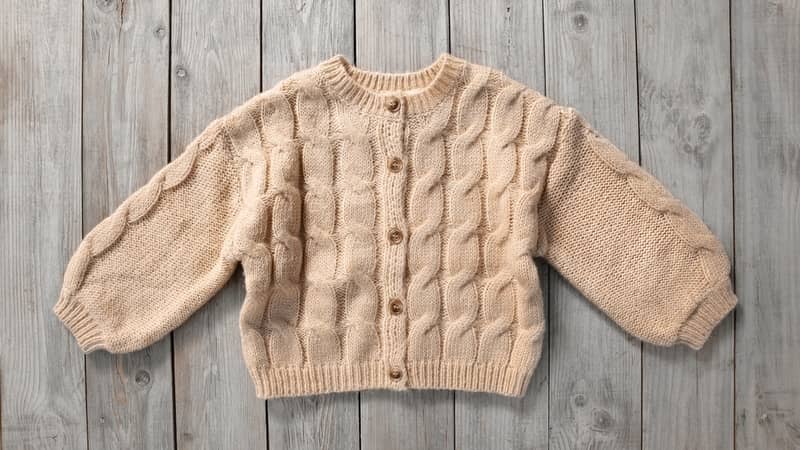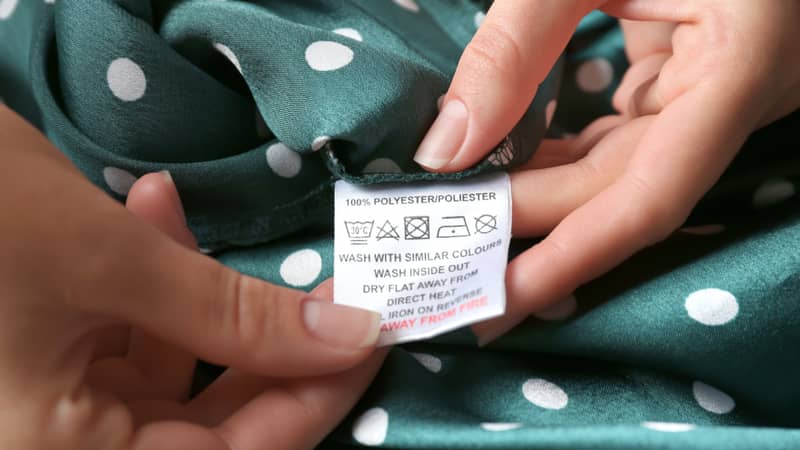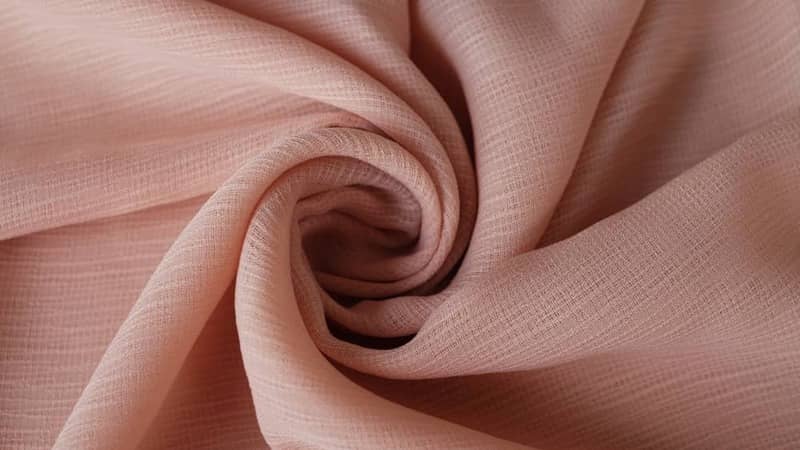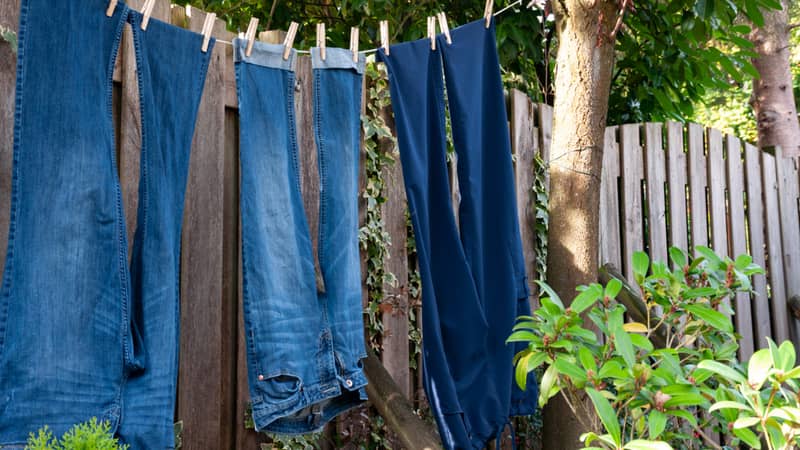Finding the perfect fit for your clothing can sometimes be a challenge, especially when garments stretch out over time or don’t match your size to begin with.
The process of altering a garment’s size requires a delicate balance between achieving the desired fit and maintaining the integrity of the fabric.
Before you begin, you should understand the mechanics behind the process of shrinking clothes.
Things You Should Know About Shrinking Clothes
Here’s the thing — not all fabrics can be shrunk.
Synthetic fabrics, such as polyester and nylon, are more difficult to shrink than natural fabric types.
Some fabrics, like silk and linen, can be damaged by heat — so there’s a high chance your clothes might end up being unusable.
The clothes shrinking process can also cause fabrics to fade and lose their shape.
This is why the key to successfully shrinking clothes lies in understanding the type of fabric you’re dealing with.
Each material reacts differently to heat, water, and agitation.
Knowing how your garment will respond to these elements will ensure you shrink it without causing damage.
Shrinking Cotton | Shrinking Wool | Shrinking Polyester | Shrinking Viscose | Shrinking Jumpers | Shrinking Denim | Shrinking Older Garments | Shrinking Without a Dryer
How to Shrink Cotton

Cotton is one of the most common materials in clothing, known for its softness and durability.
Cotton and other natural fibres are quite responsive when it comes to shrinking.
They contain cellulose fibres that contract when exposed to heat and moisture.
Step 1: Preparation
Before washing, turn your cotton garment inside-out to prevent any colour fading.
Step 2: Choose wash settings
Set your washing machine to a warm or hot water cycle.
Choose the highest heat setting if you have a particularly oversized piece of clothing.
Washing cotton clothes in warm to hot water will relax the fibres, causing them to contract once they cool.
So, the warmer the water, the more your cotton clothes will shrink.
Step 3: Select a drying cycle
If you want to shrink your clothes some more, place the cotton item in the dryer on a medium or high heat setting.
Monitor the drying process and periodically check the fit of your clothing to avoid over-shrinking.
Of course, you can always skip this step and let your cotton clothing air dry.
Step 4: Flatten and reshape
When you’re happy with the fit and size of your clothes, put the garment on a flat surface and reshape it by hand while it’s still warm.
How to Shrink Wool or Cashmere

Ever had a wool sweater that was just too big?
Rather than walking around looking like you’re in a giant’s clothes, you’re better off shrinking them.
Wool and cashmere are delicate materials derived from animal hair fibres. These fibres have a natural crimp and elasticity.
When wool or cashmere is exposed to heat and agitation, the fibres can lock together, which is a process known as felting.
This not only shrinks the garment, but can also alter its texture.
But there is a safe way to shrink clothes made of these materials.
Step 1: Preparation
Gather all materials and clear a workspace before attempting to shrink wool or cashmere.
Lay out a clean towel on a flat surface, and have a basin or tub ready for soaking.
Fill the basin with lukewarm water and add a small amount of mild detergent.
The detergent helps maintain the fabric’s natural oils, ensuring the garment remains soft and pliable.
Step 2: Submerge your clothing

Gently place your wool or cashmere garment in the water.
Make sure to press down so it’s fully submerged — you want all those wool fibres soaked.
Step 3: Swish the garment around
With your hands, softly move the garment around in the water.
This agitation in the presence of warmth and moisture encourages shrinkage.
Avoid wringing or rubbing aggressively, as it can lead to felting or damaging the fabric.
Step 4: Soak your clothes for 20-30 minutes
Allow the garment to soak in the water for about 20-30 minutes.
This ensures the cashmere or wool fibres are thoroughly saturated and ready for shrinking.
Step 5: Rinse with cool water
After soaking, drain the basin or tub and gently press the garment to release excess soapy water.
Refill the basin with cool water and submerge the garment, moving it gently to rinse out any remaining detergent.
You might need to repeat this process a couple of times until the water runs clear.
Step 6: Remove excess water
Place the garment on a clean towel and gently roll it up.
Press down to remove excess water.
Be careful not to wring or twist the fabric, as this can distort its shape.
Step 7: Lay flat to dry

Don’t put your wool or cashmere clothes in the dryer.
Instead, unroll the towel and place the garment on a flat surface.
Reshape the garment by hand and just wait for it to dry.
Check on your clothes every now and then, as they will start to shrink while they’re drying.
Step 8: Store correctly
Once the item is dry, store it folded in a drawer or on a shelf.
Like any wool or cashmere piece of clothing, do not hang it because this can lead to stretching and distortion over time.
How to Shrink Polyester
Polyester and other synthetic fibres are known for their resistance to wrinkling and durability.
Unlike natural fibres like cotton or wool, polyester doesn’t shrink easily.
However, it’s not entirely immune to the effects of heat.
When attempting to shrink polyester, wash in warm water and dry on medium heat. This can result in some contraction.
But you should avoid high temperatures, as excessive heat can deform polyester and lead to more creases or warping.
Step 1: Preparation and pre-wash inspection

Before you start the shrinking process, always check the garment’s care label.
Some polyester items may have specific washing or drying instructions due to blends with other fabrics or special finishes.
Then, look over your garment for any stains or marks.
Treat these before washing so they don’t set further during the shrinking process.
Step 2: Set your washing machine to use warm water
Polyester is resistant to shrinkage, so using warm water can help facilitate the shrinking process.
Avoid using the hot water setting for shrinking polyester, as it might degrade the quality of the fabric.
Also, while polyester is quite resilient, it’s best to use a mild detergent for your clothes.
Step 3: Add the garment and wash
Place the polyester garment in the washing machine.
Allow it to go through a full wash cycle.
The combination of warm water and agitation will begin the shrinking process.
Step 4: Set dryer to medium heat

After the wash cycle is through, transfer your wet polyester garment to your dryer.
Set the dryer to a medium heat setting.
High heat can sometimes cause polyester to melt or deform, so medium heat is a safer choice.
Step 5: Monitor the drying process
Depending on how much you want to shrink your clothes, you might want to check the garment every 15-30 minutes.
You can also try it on (if it’s wearable) to help gauge how much it shrank.
Step 6: Air out after drying
Once the drying cycle is complete, remove the garment promptly to reduce wrinkles.
You can repeat the washing and drying process if you want to shrink your clothes more.
Step 7: Store correctly
After shrinking, hang or fold the polyester garment appropriately.
Proper storage will help keep its new size and shape.
Step 8: Optional step
For future washes, if you want to maintain the garment’s new size, wash in cold water and air dry.
This will prevent any potential re-shrinking or additional wear from heat.
How to Shrink Viscose

Viscose is a type of rayon, which is a semi-synthetic fabric.
It requires a delicate shrinking process due to the fibre’s sensitivity to water and heat.
Here’s how you can shrink viscose safely:
Step 1: Check the care label
Some viscose clothing is dry-clean only, and attempting to shrink these at home could ruin them.
If the label permits washing, you can proceed with caution.
Step 2: Hand wash with warm water

Fill a basin with warm water — not hot, as viscose can react poorly to high temperatures.
Add a small amount of mild detergent to the water and swish it around to distribute it evenly.
Submerge the viscose garment and gently agitate it by hand, allowing the warm water to penetrate the fibres.
Avoid twisting or wringing the fabric, as this can cause it to lose its shape.
Step 3: Soak for 5-10 minutes
Let the garment soak for about 5-10 minutes.
Do not leave it in the water for too long, as viscose can weaken when wet, making it more prone to damage.
Step 4: Rinse with lukewarm water
Drain the soapy water and rinse the garment with lukewarm water until the soap is completely washed out.
It’s important to rinse thoroughly to prevent detergent residues from remaining in the fibres.
Step 5: Dry flat and reshape
Lay the garment flat on a clean, dry towel, and roll it up to press out excess water.
Again, do not twist or wring the fabric.
Unroll the towel and remove the garment.
Lay it flat on a drying rack or another clean towel, reshaping it gently to its original form.
Allow it to air dry on the same towel.
Step 6: Check the new size and repeat if needed
Once the garment is dry, check to see if it has shrunk to your desired size.
If you need to shrink it further, you might repeat the process, but always be cautious to prevent damage.
How to Shrink a Jumper
The amount of shrinkage will vary depending on the fabric of the jumper and how long it is washed or dried.
Step 1: Check the care label
Check the care label on your jumper to make sure it can be washed in hot water.
If the label allows, wash your jumper in hot water.
Use a wool-specific detergent for wool jumpers and opt for a gentle cycle on your washing machine.
Alternatively, you can hand wash to prevent felting and maintain the knit structure.
Step 2: Wash with warm water with gentle detergent
Prepare a basin with hot water and add a few drops of mild, bleach-free detergent.
You’ll need to turn the jumper inside out to protect the fabric before washing it to preserve the fabric.
Gently agitate the jumper with your hands, then let it soak for 15–30 minutes.
For wool, a wool-safe detergent is necessary to protect the fibres.
Step 3: Hand wash for more control
Hand washing gives you greater control over the process for more delicate jumpers or those made from shrink-prone materials like wool,
Fill a basin with warm water, add the detergent, and submerge the jumper.
Gently work the soapy water through it without stretching or pulling the fabric.
Step 4: Rinse thoroughly
Rinse the jumper in cold water. Use your hands to rinse the jumper thoroughly.
When you’re done, wring out excess water gently — be sure not to twist too tightly.
Step 5: Dry flat
Lay the jumper flat on a clean, dry towel, away from direct heat or sunlight.
Reshape it gently to its original dimensions — keep in mind that wet wool can be stretched easily.
For cotton or synthetic jumpers, you may hang them to dry if you’re not concerned about stretching.
Wool jumpers should be dried away from direct heat sources to prevent uneven shrinking or felting.
Step 6: Check the size
Check your jumper periodically as it dries.
If it isn’t shrinking as much as you’d like, you can repeat the wash in slightly warmer water or use a dryer on a low heat setting for a short period.
Step 7: Steam to finalise the fit
Once the jumper is dry, use a steamer or an iron on the steam setting to steam the jumper gently.
This can help to “set” the shrinkage and remove any wrinkles.
Be sure to use a pressing cloth if ironing to avoid direct contact with the fabric.
How to Shrink Denim

Did you buy pants that were a size too big?
It happens to the best of us.
Step 1: Determine how much you want to shrink
Unlike the previous fabric types, you’ll need to wear your denim garment to figure out your desired size.
The degree of shrinking determines how aggressively you will proceed.
Our cheat sheet is to use cold water for mild shrinkage or hot water for maximum shrinkage.
Step 2: Turn your denim inside out and submerge
Turning clothes inside out helps protect the exterior of the denim from excessive wear and fading during the washing and drying process.
Place your denim garment in the water, ensuring it’s entirely submerged. If you’re using a washing machine, let it go through a full wash cycle.
Use a detergent suitable for dark or coloured fabrics.
Step 3: Transfer to dryer

After washing, move your denim to the dryer while it’s still very wet.
Choose the heat setting you want — the hotter the setting, the more shrinkage you can expect.
However, be aware that very high temperatures can also cause more wear on the fabric over time.
Step 4: Remove from the dryer immediately
Denim can shrink rapidly, especially in a hot dryer.
Periodically check the fit (if the garment is wearable) to prevent over-shrinking.
Once you achieve the desired size, remove the denim from the dryer immediately.
Step 5: Wear to reshape into the right size
While the denim is still slightly warm and pliable from the dryer, wear it.
This will help the garment mould to your body shape, ensuring a perfect fit.
Optional: Denim maintenance

To maintain the new size of your denim, consider washing in cold water for subsequent washes and air drying.
This helps prevent further unwanted shrinkage and maintains the fabric quality.
How to Shrink Pre-shrunk and Older Garments
Pre-shrunk garments have already undergone a process to minimise shrinkage.
Older garments might have seen wear and tear and many washes.
You will need to know their fabric composition to effectively shrink them and keep your clothes from falling apart.

Step 1: Turn the clothes inside out
To protect the garment’s exterior and any prints or decorations, always turn it inside out before washing and drying.
Step 2: Wash the clothes
The heat will help to break down the fibres slightly, making them more receptive to shrinking again.
Fill a basin or tub with hot water, and immerse the garment completely.
Allow it to soak for about 30 minutes.
For a more aggressive approach, wash the garment in the washing machine to its highest heat setting.
Add a mild detergent to ensure the garment gets clean in the process.
Step 3: Dry clothes on high heat
Transfer the still-wet garment to a dryer.
Set the machine to its highest heat setting.
The combination of washing in hot water and drying on high heat will maximise potential shrinkage.
Step 4: Try on the garments

Monitoring it during the drying process is important.
This is because you’re trying to shrink a garment that’s already been pre-shrunk or is older and has been washed many times.
Once you’ve checked and believe it’s close to the right size, remove the garment while it’s still slightly damp. Wear it.
This allows it to mould to your body, ensuring a better fit.
Step 5: Air dry to remove excess moisture
Lay the garment flat on a clean towel or hang it up, allowing it to dry naturally.
This will solidify the shrinkage achieved during the heated drying process.
Step 6: Repeat if necessary
If the garment hasn’t shrunk to your satisfaction, you can repeat the process.
Remember, each time you use heat, you risk the fabric’s integrity and appearance, so proceed with caution.
How to Shrink Clothes without a Dryer
So, let’s say you don’t have a dryer and most of the instructions above won’t work for you.
There are ways you can shrink clothes on purpose without having to buy another appliance.
Boiling water

Heat is a primary agent of shrinkage. The hotter the water, the more potential for shrinkage.
But be careful with very delicate fabrics as they might get damaged.
Begin by filling a basin or tub with hot water.
Submerge the garment fully in the water, letting it sit for a few minutes.
Remove the garment carefully, let it cool, and lay it flat to dry.
Sun dry or air dry
After washing the garment in hot water, lay it flat under direct sunlight.
The combination of evaporation and sunlight can cause some fabrics to shrink.
Steam iron

The hot air from a steam iron can shrink clothes without washing them.
However, you will need to check the care label for different fabrics.
Apply steam to the garment and focus on areas you wish to shrink.
The heat from the steam iron can cause localised shrinkage.
FAQs About Shrinking Clothes
Do I need to care for my shrunken clothes differently?
Yes, you may need to care for your shrunken clothes differently than you would for non-shrunken clothes.
This is because shrunken clothes are more likely to shrink further if they are washed and dried incorrectly.
Here are some tips:
- Wash shrunken clothes in cold water.
- Use a mild detergent.
- Avoid using fabric softener.
- Dry shrunken clothes on a low heat setting or let air dry.
Can you shrink a shirt without washing it?
Yes, but you’ll need a steam iron to shrink specific areas.
What makes clothes shrink fast?
You need to use heat to shrink clothing.
Hot water and high dryer temperatures are the fastest ways to shrink your clothes.
Is there a way to safely shrink clothes?

Absolutely. Safely shrinking clothes involves understanding the fabric type, monitoring heat exposure, and avoiding over-agitation.
Can you shrink clothes by just drying them?
Yes, especially for cotton garments. The heat from the dryer can cause fabrics to contract.
What fabrics should I not shrink?
Leather, suede, silk and linen. Also, any items that are structured and have embellishments.
You shouldn’t shrink these fabrics due to their structure, treatment or risk of damage.
Don’t Sweat the Small Stuff
Shrinking clothes might seem like a tricky endeavour, but with the right knowledge and patience, you can achieve the perfect fit.
It’s essential to understand the nature of the fabric you’re working with and to be gentle in the process.
Overexposure to heat and agitation can damage your clothes, so always be cautious.
If ever in doubt, ask a professional cleaner about their laundry tips for your specific garments.
After all, when it comes to fashion and comfort, it’s the little things that matter most.

